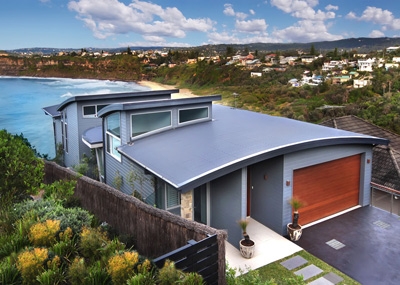
Find out what you need to consider when you’re choosing a location to build your house on, and why comfort, convenience and safety are so important.

Once you’ve settled on the idea that you’re going to build a house, the first step is to decide where you’re going to put it. Choosing the right spot’s a pretty big deal, for a few reasons.
It’s a very tired cliché, but real estate agents are absolutely right when they say the three most important aspects of a house are:
- location
- location, and
- location
There are normally some extremely good reasons that make a patch of dirt in one area worth more than a patch of dirt in another – but of course everyone’s needs and preferences are slightly different.
What to look for
Building’s never cheap – and for that reason it’s easy to tie yourself in knots thinking about what your house is likely to be worth in a few years. If you’re going to be building a home for your family to live in for the foreseeable future though, pinning down a precise resale value really shouldn’t be your first concern.
If you’re building a home to live in, you should set your sights firmly on finding a location that’s:
a) comfortable
b) convenient
c) safe, and
d) within your budget
These are the things that most people instinctively want when they choose a location for their home anyway. Providing that you’re choosing a location within your budget that objectively fulfils the first three of these things, you shouldn’t have much trouble finding a good price for it if and when you’re ready to sell.
Choosing a location for an investment property
Building solely for investment purposes over the short term is a completely different kettle of fish – and a notoriously dark art. Historical price fluctuations and rental demand in surrounding suburbs, planned developments in the vicinity, suburb ‘prestige’, rate of gentrification and the overall state of the local market are just a few of the things that need to be factored in.
If you’re looking to choose a strategic location for an investment property, you’ll need to consider things far more carefully, and understand how that works so that you can make an informed decision.
What is a ‘comfortable’ location?
How ‘comfortable’ a location is for you won’t always be easy to define. Convenience and safety are contributing factors, but the kind of lifestyle you prefer is just as important. We’ve all got different tastes – some of us love the tropics, some of us can’t sleep without the dull, constant buzz of traffic noise, and some of us need space to build a dam and catch yabbies while looking out across an uninterrupted horizon.
Most people know roughly where they want to build. If you’re not already 100% clear about this, try and get your head around the kinds of things you categorically need (or need to avoid) to be genuinely comfortable in any given location.
How to measure ‘convenience’
Convenience is a big deal when you’re choosing where to build a home. Think about your own life (and those of the rest of your family). The sorts of things that make a particular location ‘convenient’ are those that make it easy to get where you need to go easily, and ensure that all the things you want are nearby. When you’re choosing a location, consider:
1. Where the main breadwinners work, and how long it’ll take them get there via public transport / car / bicycle etc.
2. Which way traffic generally flows – it’s far easier to go against traffic in peak hour if you’re able!
3. What schools you want your kids to go to
4. Where the rest of your family and friends live
5. Whether or not you have any passionate interests or hobbies that you might need to travel for
6. The sorts of amenities and facilities that are nearby (e.g. supermarkets, parks, gyms, restaurants, libraries, hospitals, petrol stations etc.)
One quick and dirty way to assess the general ‘convenience’ of a location is to determine how many things are easily accessible by foot in that area too. WalkScore is a great website which can help you to determine what sorts of things are within walking distance of a given address, and how generally ‘convenient’ it is.
How to measure ‘safety’
Obviously it’s impossible to objectively measure how safe any given area is – but there are ways to get a ‘feel’ for the character of a neighbourhood without strolling around at midnight – and to figure out what kinds of social issues and general threats exist there.
Crime statistics are readily available for many parts of Australia, and along with demographic stats, they can paint a pretty vivid picture of how safe a neighbourhood or location is likely to be. Most of the time all you’ll need to do to find them is to search the internet for ‘crime map [state or city name]’, or ‘demographic statistics [state or city name]’.
Here are a couple of other sites that’ll provide a bit more information on the general statistics for a given area:
http://home.id.com.au/public-resources/demographic-resource-centre/community-profile/
http://www.oktravel.com.au/au/
Keep in mind that some of the stats you’ll find are based purely on the number of crimes, and that for a fair picture they should be measured against how many people live in the area (e.g. number of property crimes per 1000 people). Likewise, for new housing estates on greenfield, brownfield or greyfield land, these statistics will change pretty quickly when houses go up and people start to move in. Where that’s the case you may want to compare with similarly developed locations around the same area.
Other safety issues to consider
Bad guys aren’t the only safety issue you’ll need to consider. When you’re choosing a location, you should also take into account the likelihood of:
- bushfires
- flooding
- high winds (or cyclones if you’re up north)
- soil movement
- termites and borers, and
- the presence of dangerous chemicals or salt in the soil
This looks like a pretty daunting list, but it’s normally no trouble to find out which of these things you’ll need to worry about. Many of them can be managed easily with the right preparation and building techniques.
Next up: choosing a plot of land
Based on the factors above, you should be able to settle on a location that’ll accommodate your family’s existing commitments and tastes – and have a fighting chance of identifying what’s likely to make some areas or suburbs more appropriate than others.
Once you know which areas you’re looking at, you can narrow your focus to choosing the best possible plot of land…




